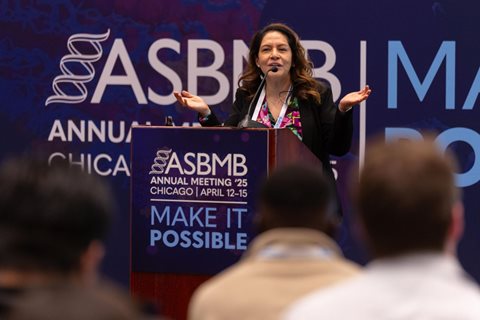Disease discoveries in three realms of the RNA world
The RNA world is key to understanding gene expression in eukaryotes. This track will include three sessions describing exciting discoveries in RNA and disease: small noncoding RNAs, RNA modifications and RNA binding proteins.
The session on small noncoding RNAs will focus on discoveries in model systems and humans regarding transfer RNAs, tRNA fragments and Piwi-interacting RNAs regarding their biogenesis, functions, and roles in development and disease.
After transcription, nearly every type of RNA becomes decorated with nucleoside modifications; the RNA modification session will describe novel roles these modifications play in decoding, RNA stability and RNA regulation and activities. It also will describe how these modifications function in normal and aberrant biological states.
RNA functions rely on interactions with RNA binding proteins; the session on RNA binding proteins will describe how RNA-protein interactions regulate chromatin structure, transcription and splicing and how the interactions are involved in development and disease.
Keywords: small noncoding RNAs, RNA modification, RNA binding proteins, tRNA, piRNA, miRNA, tRNA fragments, gene expression, stem cells, muscle cells, development, cancer.
Who should attend: everyone who wants to learn how the RNA world impinges on gene expression in health and disease.
Theme song: “Hello, Goodbye” by the Beatles, because the song reminds us of the life of RNAs in a cell.
This track is powered by different kinds of RNAs — obviously.
Talks
- tRNA: Splicing and subcellular dynamics — Anita Hopper, Ohio State University
- The role of 3’tsRNAs in gene regulation — Mark Kay, Stanford University
- The Piwi-piRNA pathway: A new paradigm in gene regulation — Haifan Lin, Yale University
- piRNA biogenesis and function in Drosophila — Mikiko Siomi, University of Tokyo
- RNA modification in cancer — Jianjun Chen, Beckman Research Institute of City of Hope
- RNA modifications in health and disease — Tsutomu Suzuki, University of Tokyo
- Acetylation of cytidine in messenger RNA regulates translation — Shalini Oberdoerffer, National Cancer Institute
- tRNA quality control: Mechanisms, evolution, and implications for human disease — Eric Phizicky,University of Rochester Medical Center
- RNA binding proteins in stem cells and cancer — Takahiro Ito, University of Georgia
- The RNA exosome and genetic disease — Anita Corbett, Emory University
- RNA, chromatin, and the coordinated control of gene expression — Tracy Johnson, University of California, Los Angeles
- How mRNP composition determines mRNA fate — Guramrit Singh, Ohio State University
Enjoy reading ASBMB Today?
Become a member to receive the print edition four times a year and the digital edition monthly.
Learn moreFeatured jobs
from the ASBMB career center
Get the latest from ASBMB Today
Enter your email address, and we’ll send you a weekly email with recent articles, interviews and more.
Latest in Careers
Careers highlights or most popular articles

Building the blueprint to block HIV
Wesley Sundquist will present his work on the HIV capsid and revolutionary drug, Lenacapavir, at the ASBMB Annual Meeting, March 7–10, in Maryland.

Upcoming opportunities
Present your research alongside other outstanding scientists. The #ASBMB26 late-breaking abstract deadline is Jan. 15.

Designing life’s building blocks with AI
Tanja Kortemme, a professor at the University of California, San Francisco, will discuss her research using computational biology to engineer proteins at the 2026 ASBMB Annual Meeting.

Upcoming opportunities
#ASBMB26 late-breaking abstract submission opens on December 8. Register by Jan. 15 to get the early rate on our Annual Meeting.

Make your abstract stand out
Ensure your research is impossible to overlook. Get quick, practical reminders for crafting an abstract that attracts readers and helps you build connections at the conference.

Inside industry postdocs
As more Ph.D. scientists look beyond academia, industry postdocs offer a new kind of training, where mentorship meets mission-driven research. Fellows at Pfizer and Genentech share how these programs prepare them to translate discovery into impact.


